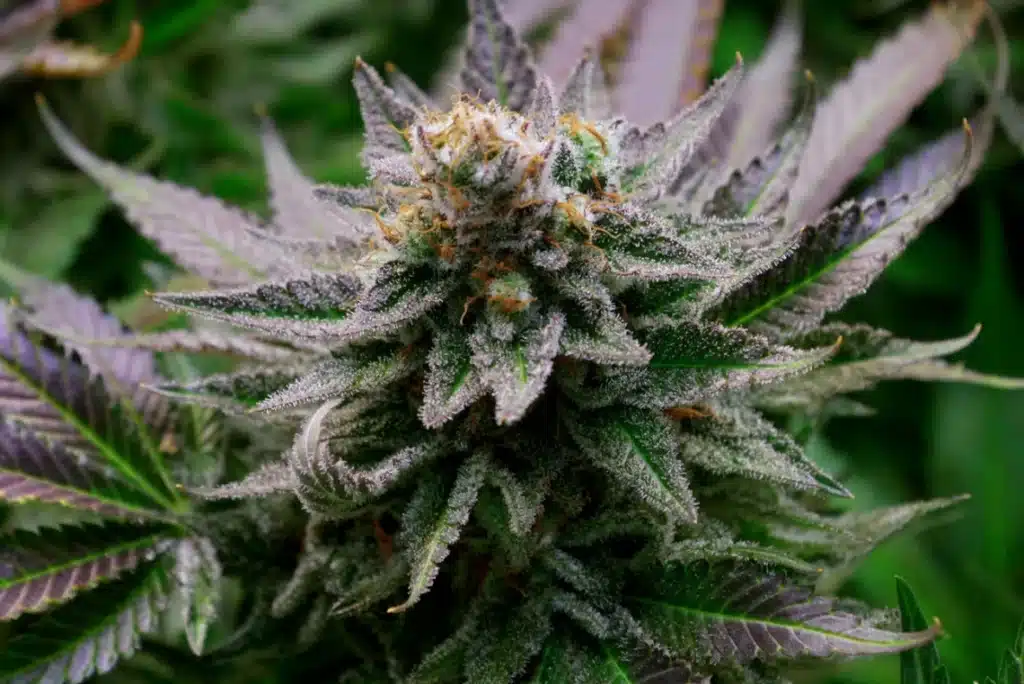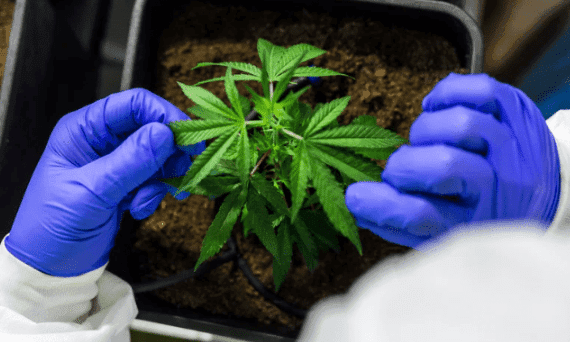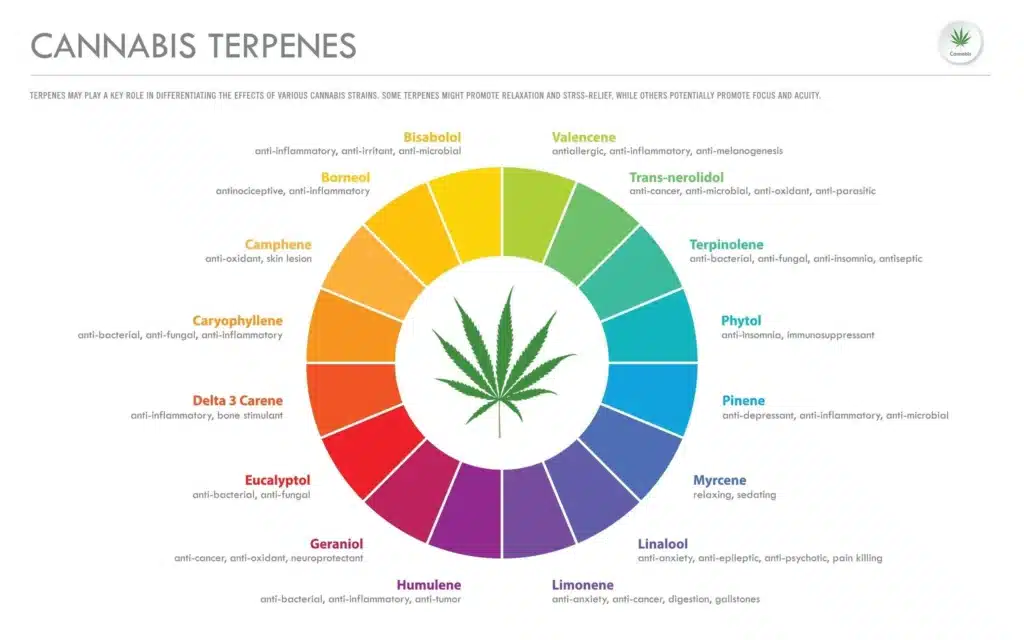As the cannabis market is maturing and evolving, compliance requirements are on the rise. Customers are also increasingly looking at the labels to understand what is in their product. Cannabis terpene testing is a crucial analysis that provides insights into chemical profiles explaining why different strains produce unique effects, flavors, and aromas.
So, what exactly do labs examine during terpene analysis, and why should you care? That’s what we are about to explore here. Terpene testing can be instrumental in making informed decisions about cultivation, product development, and consumption.
Sections
ToggleWhat Are Terpenes in Cannabis?

Terpenes are organic aromatic compounds in plants that provide distinctive scents, flavors, and potential therapeutic effects. Not only in cannabis, but also in all plants, terpenes are present. In cannabis, they work synergistically with cannabinoids like THC and CBD to create what researchers call the “entourage effect.” There are over 200 different strains identified, each strain containing a unique terpene profile.
Why Terpene Testing Matters More Than Ever
Terpene testing is more relevant for cannabis products for several reasons:
- Product Consistency:
It ensures that cannabis products maintain consistent profiles across batches. It is essential to deliver a reliable experience to consumers every time. - User Experience:
With terpene testing, producers can predict effects, flavors, and aromas. It helps market the right product to the right consumers. - Medical Relevance:
Cannabis terpene testing is also essential to select strains for medical cannabis patients. Testing results can help find specific terpene combinations that may enhance therapeutic benefits. - Brand Integrity:
With reliable terpene analysis, cannabis product manufacturers can back their marketing claims with scientific results.
How Is Terpene Testing Done in Labs?

Terpene labs follow a standard operating procedure to analyse the terpene profile in cannabis.
1. Sample Preparation
The testing begins by extracting flower, concentrate, or oil products samples. Lab technicians must work quickly to maintain sample integrity as terpenes are volatile compounds. Proper storage and minimal exposure are essential to prevent degradation or evaporation of the sample.
2. Analytical Techniques
Labs then run the sample through Gas Chromatography (GC), the standard method for terpene analysis. Two common types include:
- GC-FID (Flame Ionization Detection): Measures the amount of each terpene present with high precision.
- GC-MS (Mass Spectrometry): Identifies each terpene based on molecular structure and is excellent for complex profiles.
These tests can detect terpene levels down to parts per million, making them ideal for detailed profiling.
3. Quality Control Measures
Professional terpene labs implement rigorous quality control protocols, including regular calibration with certified reference standards, for consistent results across testing sessions. Standardization is essential.
Common Terpenes Found in Cannabis

Terpene | Scent/Flavor | Effects |
Myrcene | Earthy, musky, herbal | Sedating, muscle relaxant, sleep-promoting |
Limonene | Citrus, lemon, orange | Mood elevation, stress relief, antimicrobial |
Pinene | Pine, forest, sharp | Alertness, memory retention, anti-inflammatory |
Caryophyllene | Spicy, peppery, woody | Anti-inflammatory, pain relief, anxiety reduction |
Linalool | Floral, lavender, sweet | Calming, anti-anxiety, sleep aid |
Repeatability testing involves analyzing the same sample multiple times to verify precision. It compares results across different instruments and operators to ensure accurate terpene test results.
Who Benefits from Terpene Testing?
Terpene testing is beneficial for stakeholders across the board, including:
- Growers:
Cultivators can use terpene analysis to optimize growing conditions and select the best genetics that produce desired terpene profiles. - Product Manufacturers:
Cannabis product manufacturers can significantly improve their offerings with terpene testing by maintaining consistent formulations with specific effects and flavor profiles. - Testing Labs:
Terpene labs can expand their service offerings as the cannabis product market grows. They can help clients understand their products’ complete chemical composition. - Consumers:
End users benefit from cannabis terpene testing as it aids their informed purchasing decisions based on scientific data rather than marketing claims.
Terpenes and the Entourage Effect
The entourage effect is the traditional ” high ” that conventional “high” consumers experience from cannabis. Terpenes work synergistically with cannabinoids to modulate cannabis effects, creating experiences more optimized and flavorful than the sum of individual compounds. Terpene testing results show that minor terpenes, even in small concentrations, can significantly influence a strain’s overall effects and therapeutic potential. With a proper combination, manufacturers can offer full-spectrum THC and CBD cannabis products.
Terpene Testing vs. Potency Testing
It is easy to confuse terpene testing with potency testing, but there’s a significant difference. Potency testing measures cannabinoid concentrations like THC and CBD, but terpene analysis provides information about flavor, aroma, and potential effects.
Two strains with identical cannabinoid levels can vastly differ in experiences based on their terpene profiles. Combining potency and terpene testing offers complete product characterization for informed decision-making, explaining why certain products feel energizing while others promote relaxation.
Future of Terpene Testing in Cannabis
As the industry matures, expect to see:
- More advanced lab technologies, including AI-assisted terpene identification.
- Deeper terpene databases for more precise strain predictions.
- Regulatory requirements making terpene testing a standard practice.
Growth in personalized cannabis experiences based on terpene profiles.
Conclusion
Cannabis terpene testing is fundamental in creating improved product consistency, enhanced consumer experiences, and deeper therapeutic insights. Manufacturers can integrate comprehensive terpene analysis into standard testing protocols, ensuring they and their consumers can access the detailed chemical information necessary for informed decision-making.




